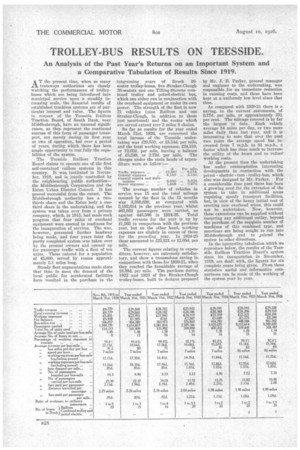TROLLEY-BUS RESULTS ON TEESSIDE.
Page 12

If you've noticed an error in this article please click here to report it so we can fix it.
An Analysis of the Past Year's Returns on an Important System and a Comparative Tabulation of Results Since 1919.
AT the present time, when so many tramways authorities are closely watching the performances of trolleybuses which are being introduced into municipal service upon a steadily increasing scale, the financial results of established trackless systems are of particular interest and value. The figures in respect of the Teesside Railless Traction Board, of South Bank, near Middlesbrough, have an unusual significance, as they. represent the continued success of this form of passenger transport, not merely during its first year or two of operation, but over a period of years, during which there has been ample opportunity to test fully the capabilities of the system.
The Teesside Railless Traction. Board claims to operate one of the first self-contained railless systems in this country. It was instituted in November, 1919, and is jointly controlled by the neighbouring public authoritiesthe Middlesbrough Corporation and the Eston Urban District Council. It has proved successful from the outset. The Middlesbrough authority has a twothirds share and the Eston body a onethird share in the undertaking, and the system was taken over from a private company, which, in 1915, had made such progress that four miles of overhead equipment were erected in readiness for the inauguration of services. The war, however,, prevented further headway being made, and four years later the partly completed system was taken over by the present owners and opened up for passenger traffic with a fleet of ten units. These catered for a population of 45,000, served by routes approximately 5.1 miles long.
Steady fleet augmentations made since that time to meet the demand of the local public for accelerated facilities have -resulted in the purchase in the
intervening, years of Brush 26seater trolley-buses, five Straker-Clough 36-seaters and one Tilling-Stevens combined trolley and petrol-electric bus, which can either run in conjunction with the overhead equipment or under its own power. The strength of the fleet is now 21 vehicles (nine Railless and one Straker-Clough, in addition to those just mentioned) and the routes which are served extend over 5 miles 8 chains.
So far as results for the year ended March 31st, 1926, are concerned the total income of the Teesside undertaking was 129,559, or 15.34d. per mile, and the total working expenses, 124,310, or 12.62d. per mile, leaving a balance of 15,249, or 2.72d. per mile. The charges under the main heads of "apeutliture were as follow: Per mile. T ...
Traffic expenses 12.847 ... 6.674. General expenses ... 4,145 ... 2.154. General repairs and main tenance ... 5.650 ... 2.93d.
Power expenses ... ... 1,668 ... 0.874.
The average number of vehicles in service was 15 and the total mileage covered by the fleet in the 12 months was 3,389,630, as compared with 3,152,614 in the previous year, whilst 462,562 passengers were carried, as against 448,566 in 1924-25. Total traffic revenue for the year is up by 11,263 in comparison with the previous year, but on the other hand, working expenses are slightly in excess of those for the preceding year. In 1924-25 these amounted to 3E22,521 or 12.05d. per mile.
The current figures relating to expenditure, however, are extremely satisfactory, and show a tremendous saving in comparison with those for 1920-21, when they reached the formidable average of 18.39d. per mile. The purchase during 1922 and 1923 of five Straker-Clough trolley-buses, built to designs prepared by Mr. J. B. Parker, general manager and engineer to the undertaking, was responsible for an immediate reduction in running costs, and these have been kept at a uniformly low level since that time.
As compared with 1920-21 there is a saving, in the current statements, of 5.77d. per mile, or approximately 33i per cent. The mileage covered is by far the largest to date. Each vehicle average 84 miles per day, or two more miles daily than last year, and it is interesting to note that over the past two years the average speed has in creased from m.p.h. to 84; m.p.h., a factor which has done much to increase the utility of the buses and to reducE working costs.
At the present time the undertaking has under contemplation interesting developments in connection with the petrol electric cum trolley-bus, which also was designed by Mr. Parker. For a considerable time past there has been a growing need for the extension of the System to take in additional areas requiring speedy transport facilities. but, in view of the heavy initial cost of erecting new overhead wires, this could not be undertaken. Now, however, these extensions can be supplied without incurring any additional outlay, beyond the purchase of the requisite number of machines of this combined type, and sanctions are being sought to run into Middlesbrough and to _extend the systew in other directions.
In the interesting tabulation which we reproduce below, the results of the Teesside Railless Traction Board's system since its inauguration in November, 3919, are dealt with, the figures for six complete years being given. From these statistics useful and informative comparisons can be made of the working of the system yeat by year.




























